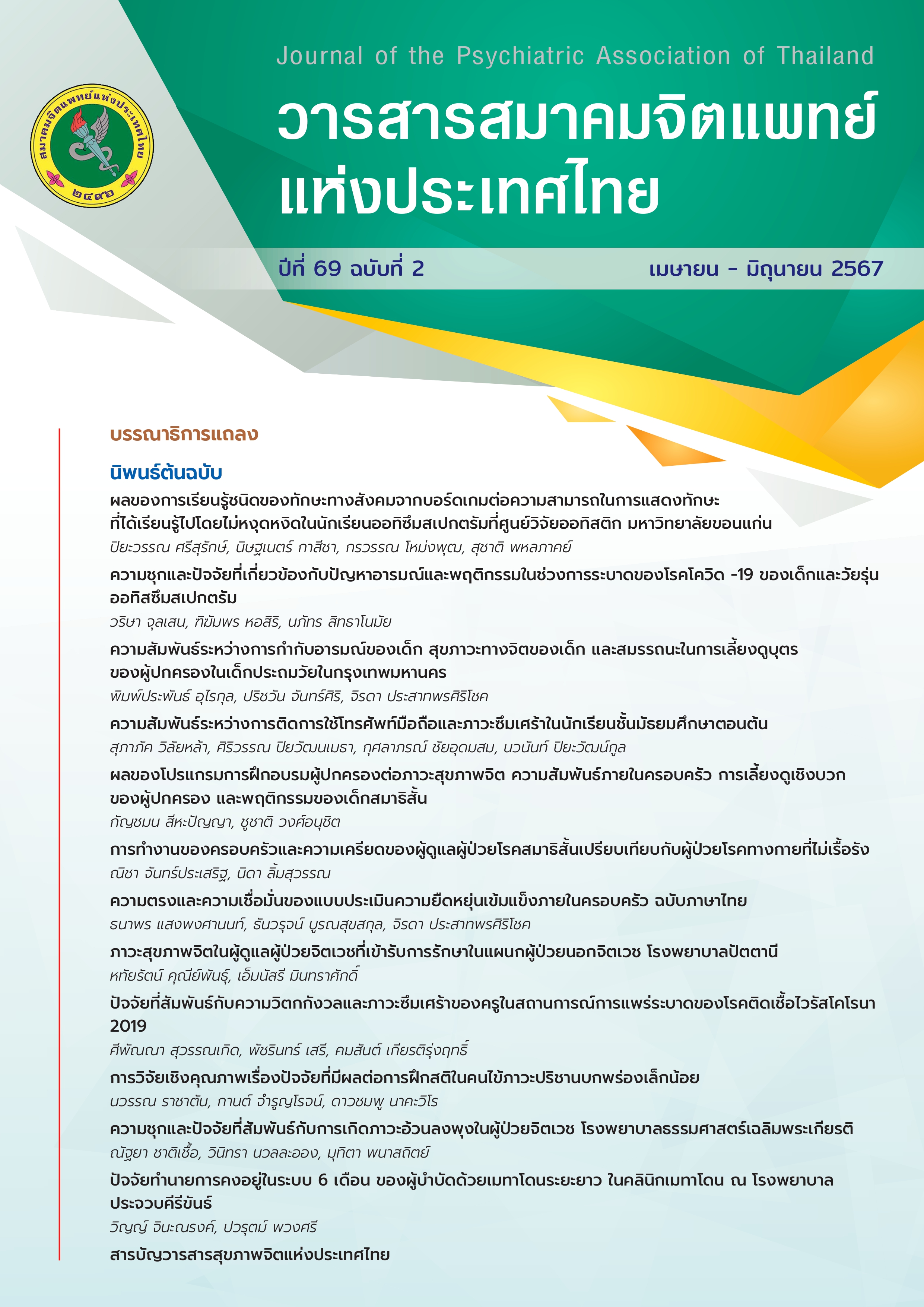Correlation Between Smartphone Addiction and Depression in Secondary School Children
Main Article Content
Abstract
Objective: To study the correlation between smartphone addiction and depression in secondary school children and related factors associated with depression in secondary school children.
Method: A cross-sectional study was conducted in secondary school children. The data was collected by using demographic questionnaire, Smartphone Addiction Scale-Thai Shot Version (SAS-SV-TH), Children’s Depression Inventory (CDI)-Thai version. The data was analyzed by descriptive analysis for general information. Analytical statistics, chi-square and Spearman’s correlation, were used to explore the relationship between smartphone addiction and depression. Logistic regression in both bivariate and multivariable analyses was applied to investigate the association between various factors and depression.
Results: Among the 290 children who were included in the study, 51% were female, smartphone addiction was statistical significantly associated with depression in secondary school children (p<0.001). Factor associated with depression in secondary school children were educational level (Adj. OR 0.19, 95%CI: 0.08 - 0.43 for grade 8, Adj. OR 0.46, 95%CI: 0.23 - 0.92, p<0.001 for grade 3), academic achievement (grade point average) (Adj. OR 0.47 95% CI: 0.26 - 0.84, p = 0.011), screen time (Adj. OR 1.10, 95%CI: 1.002 - 1.21, p = 0.045) and smartphone addiction (Adj. OR 2.92, 95%CI: 1.63 - 5.23, p<0.001).
Conclusion: The study revealed a statistically significant association between smartphone addiction and depression among secondary school children. Other factors associated with depression in secondary school children were educational level, academic achievement and screen time.
Article Details

This work is licensed under a Creative Commons Attribution-NonCommercial-NoDerivatives 4.0 International License.
Articles submitted for consideration must not have been previously published or accepted for publication in any other journal, and must not be under review by any other journal.
References
Chaiudomsom K, Arunpongpisarn S, Virasiri S. Depressive disorders. In: Chaiudomsom K, Paholpak P, Vadhanavikkit P, Aphisitphinyo S, editors. Psychiatry. 2nd ed. Khonkaen: Klungnana Vitthaya Press; 2017. p. 174.
Thongpet N. Checklist of causes and symptoms of depression [Internet]. Department of Mental Health; 2019 [cited 2023 Dec 20]. Available from: https://www.dmh.go.th/news-dmh/view.asp?id=30114.
SaeLim P. Depression: Lonely, hopeless, burned out emotional state of Millennial generation in 2019. The Momentum [Internet]. 2019 [cited 2023 Dec 20]. Available from: https://themomentum.co/millennials-mental-health-2019/.
Sadock BJ, Sadock VA, Ruiz P. Kaplan & Sadock's Synopsis of Psychiatry: Behavioral Sciences/Clinical Psychiatry. 11th ed. Philadelphia: Wolters Kluwer; 2015.
Pewnil T. Communication technology use behavior and mental health of secondary school students in Kanchanaburi Province. TU Journal 2015;34(2):134-49.
Saeb S, Zhang M, Karr CJ, Schueller SM, Corden ME, Kording KP, et al. Mobile phone sensor correlates of depressive symptom severity in daily-life behavior: An exploratory study. J Med Internet Res 2015;17:e175.
Wood JT. Interpersonal communication: everyday encounters. 7th ed. Boston (MA): Cengage Learning; 2012.
Charoenwanit S, Soonthornchaiya R. Development of smartphone addiction scale: Thai short version (SAS-SV-TH). J Ment Health Thailand 2019;27(1):25-36.
Kwon M, Kim DJ, Cho H, Yang S. The smartphone addiction scale: Development and validation of a short version for adolescents. PLoS One 2013;8(12):e83558.
Trangkasombat U, Likanapichitkul D. The Children’s Depression Inventory as a screen for depression in Thai children. J Med Assoc Thailand 1997;80:491-9.
Jiamjaroenkul J, Limsuwan N. Depression among junior high school students in Muang district, Chiang Mai province. J Psychiatr Assoc Thailand 2015;60:253-64.
Lohapattanabamrung A. COVID-19 and mental health [internet]. Department of Mental Health; 2024 [cited 2024 Feb 28]. Available from: https://dmh.go.th/news/-dmh.go.th.
Surawan W. Prevalence and factors relating to depression of junior high school students in Nam Phong District, Khon Kaen Province. J Psychiatr Assoc Thailand 2021;66(4):403–16.
Evans D, Borriello GA, Field AP. A review of the academic and psychological impact of the transition to secondary education. Front Psychol 2018;9:1482.
Krause K, Midgley N, Edbrooke-Childs J, Wolpert M. A comprehensive mapping of outcomes following psychotherapy for adolescent depression: The perspectives of young people, their parents and therapists. Eur Child Adolesc Psychiatry 2021;30:1779-91.
Rinne GR, O'Brien MP, Miklowitz DJ, Addington JM, Cannon TD. Depression, family interaction and family intervention in adolescents at clinical-high risk for psychosis. Early Interv Psychiatry 2021;15:360-6.
Männikkö N, Ruotsalainen H, Miettunen J, Kääriäinen M. Associations between childhood and adolescent emotional and behavioral characteristics and screen time of adolescents. Issues Ment Health Nurs 2020;41:700-12.
Twenge JM, Hisler GC, Krizan Z. Associations between screen time and sleep duration are primarily driven by portable electronic devices: Evidence from a population-based study of U.S. children ages 0-17. Sleep Med 2019;56:211-8.
Cai Y, Zhu X, Wu X. Overweight, obesity, and screen-time viewing among Chinese school-aged children: National prevalence estimates from the 2016 Physical Activity and Fitness in China-The Youth Study. J Sport Health Sci 2017;6:404-9.
Davey S, Davey A, Raghav SK, Singh JV, Singh N, Blachnio A, et al. Predictors and consequences of "Phubbing" among adolescents and youth in India: An impact evaluation study. J Family Community Med 2018;25:35-42.
Reinhardt I, Gouzoulis-Mayfrank E, Zielasek J. Use of telepsychiatry in emergency and crisis intervention: Current evidence. Curr Psychiatry Rep 2019;21:63.
Di Carlo F, Sociali A, Picutti E, Pettorruso M, Vellante F, Verrastro V, et al. Telepsychiatry and other cutting-edge technologies in COVID-19 pandemic: Bridging the distance in mental health assistance. Int J Clin Practice 2021;75:10.1111/ijcp.13716.


